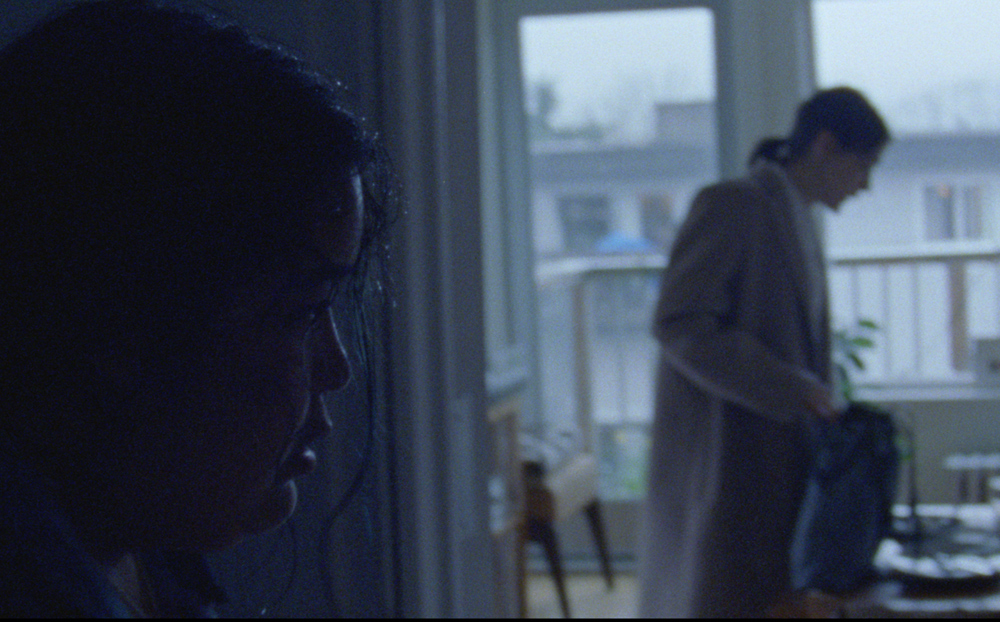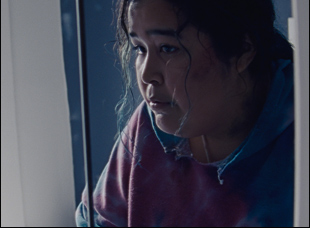Every step taken by Rosie (Violet Nelson) and Áila (Elle-Máijá Tailfeathers) in “The Body Remembers When the World Broke Open” feels a little heavier than the last. Some of it can be chalked up to the unrelenting rain that is to be expected in Vancouver, but there is something even stronger in the air after the two meet on Pender Street where Áila has found the pregnant teen, bruised and confused as she receives the help she didn’t go looking for but gradually comes to realize she needed. While the clouds remain, the skies part in the transcendent drama co-directed by Tailfeathers and “Never Steady, Never Still” helmer Kathleen Hepburn as the strangers start to take on the weight of one another as they come to know each other, both carrying the tortured legacy of the indigenous community in Canada where the scourge of domestic abuse has reared its ugly head for generations as an extension of the violence that was brought on by European colonization.
After experiencing a similar situation in real life, Tailfeathers insisted that the story unfold in real time on screen in “The Body Remembers When the World Broke Open” to replicate the harrowing moment accurately, but the long, unbroken takes that dance around Rosie and Áila have an additional benefit as Tailfeathers and Hepburn not only find tension in all the soul searching that must be done in this seemingly hopeless instance, but also the grace as Áila must locate common ground with Rosie when there’s so much she doesn’t know and has no way of finding out in this most sensitive time without inflicting more pain. Between the raw, emotionally charged performances at its core and the delicate yet determined narrative that takes you in from its first frames and doesn’t let go, “The Body Remembers When the World Broke Open,” like its central duo, draws on the immense strength it finds within itself and recently, when Tailfeathers, Hepburn, and Nelson were in Los Angeles on the eve of the film’s special engagement at the Amanda Theater on the ARRAY campus, where it opens today, in addition to being available for all the world to see on Netflix, we spoke about the trio was able to so firmly place an audience in the shoes of its characters and the genesis of this distinctive drama.
Elle-Máijá Tailfeathers: The film is inspired by an experience that I had in the same neighborhood where the film takes place and I’m not formally trained as a filmmaker. My experience with filmmaking has primarily been in documentary and my experience with narrative film has been through acting, so from the beginning, I wanted to shoot this film in real time, but knowing the technical challenges of doing that, I thought the project would benefit from co-writing and co-directing and Kathleen has been a friend for a number of years. We share a workspace together in Vancouver and I so deeply admire Kathleen’s work – her first feature “Never Steady, Never Still” is just so profoundly moving and I also just admire Kathleen as a person – so with all of this in mind, I approached Kathleen about working together and then it all…
Kathleen Hepburn: And then we did it.
When it’s a two-hander as a narrative, are you able to slip into the roles behind the scenes and challenge each other to push the narrative forward?
Kathleen Hepburn: Yeah, in terms of having someone else there to make sure every choice we were making was the right choice. That was what was so beautiful about that collaboration is that you have someone to push you further creatively, but we didn’t have a lot of disagreement over what the right choice was, which is really nice.
Elle-Máijá Tailfeathers: Yeah, we understood at the core the spirit and the intent of the story and where we wanted to take it, so we throughout the process continually reminded ourselves of why we wanted to do this, who we were doing it for and what the story was really about. Obviously, there were challenges as there is in any sort of collaboration, but we [always] were willing to hear each other out and often those challenging conversations, something really great emerged from that.
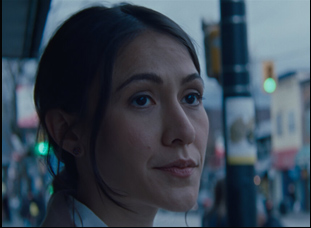
Kathleen Hepburn: Yeah, as Maija said, she had wanted to tell this story in real time, so we knew there would be a lot of silence. That’s kind of scary to go into a narrative feature, but it was very clear to us that so much happens in those silences between strangers and there’s a lot of tension in that, so it was pretty important to us to honor that tension rather than trying to fill it with dialogue that didn’t have any weight and to allow the audience to really feel that time and space.
Violet, how do you get involved in all this?
Violet Nelson: My friend messaged me about the open casting call they put out and said to “let other girls know about it, but if you want to go for it as well, you can.” And I was like, “Yeah, I’ll let other girls know about it, but I’m not going for it.” But then I told my mom and [she] said, “Why not?” And I said, “Because acting is not my thing,” and she said, “Well, how do you know?” And she wouldn’t stop bugging me about it and I was like, “Okay, fine. I’ll go for it.”
Elle-Máijá Tailfeathers: And we were just really taken by her. Again, we wanted to really root this film in realism and honor that original experience that I had, so the characters of Aila and Rosie are similar to myself and that young woman, and when it came to casting Rosie, we wanted to find someone who you would believe had this lived experience and isn’t a conventional actor. Unfortunately, this industry supports a very distinct kind of look and person and we wanted to find someone who brought a real authenticity and purpose and vulnerability and strength and also rawness to that performance. We weren’t finding it through conventional casting, so we opened it up to an open casting call in the hopes of finding a woman who brought all of that to Rosie. That’s how we found Violet and Kathleen and I both had this instinct about Violet that there was something we wanted to know more about.
That being said, the open casting call was such a challenging process because there were so many talented young women who sent in self-tapes. We were just blown away by all of these young women who were willing to put themselves out there and be brave and do this audition, and it was really hard knowing we could only cast one. There were two other young women who were really phenomenally talented and would’ve brought the film in very different directions, so we did a number of callbacks with these other young women and really thought about okay, if we cast this young woman, what does that say about the film? Where is the narrative going to go? We wanted to speak to themes of the foster care system and indigenous youth in Canada and wanted to work with themes of the complexities of class and the experiences of race and indigenous identity, and ultimately Violet was the one.
Violet, was there something you could connect to with the character?
Violet Nelson: My mom had similar experiences to Rosie – she was in an abusive relationship and I witnessed that a lot, and she’s no longer in the relationship, but that really helped me to connect to Rosie more and to understand her more.
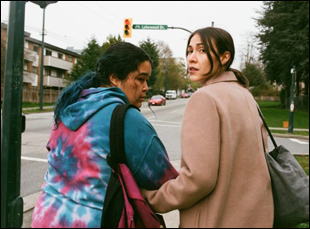
Elle-Máijá Tailfeathers: In so many ways, we worked hard to keep it real and to not play into any need to spell it out for our audience. Audiences will engage with specificity and authenticity, so very much like myself and that young woman that day, the spaces that Rosie and Aila inhabit are complicated and they’re rich and beautiful and speak to class and power and privilege and the ways that systems of oppression impact the daily realities of these two women.
Kathleen Hepburn: Also, our intention was to write to an indigenous audience because we knew the audience would understand. We didn’t want to be explaining what it means to be an indigenous woman to indigenous women. We just wanted to show life as it is. we also had really amazing production designers on this film who worked really hard to create the space that they were in and there’s so many beautiful details in that space.
Elle-Máijá Tailfeathers: Our whole art department was amazing and they did a lot of research. They also borrowed a lot of my things. [laughs] It was actually really wonderful to see some of my books and my art in that space and also to see art made by other indigenous artists in Aila’s space. A lot of the books that are in that space are monumental and have really have helped move the conversation forward about indigenous politics and lived experience and our reality as indigenous people, so the books are one of my favorite quiet nods to leading indigenous thinkers.
The use of Joni Mitchell’s “Little Green” is also quite a sly nod – and she almost never licenses her music for film. What was it like writing to her to get permission to use it?
Elle-Máijá Tailfeathers: That was surreal. We were listening to the Blue Album one day when we were working and that song “Little Green” came on and sent chills up our spine because we realized it’s so fitting for the film. It’s a song about Joni Mitchell having to give her daughter up for adoption at 19, how challenging that decision would’ve been and how it was ultimately about love for her daughter and wanting her daughter to have the best possible life.
Joni Mitchell is also part Sami, and she was born in Fort McLeod, Alberta, which is in Blackfoot Territory where I’m also from, and my mother’s a big Joni Mitchell fan, so I grew up listening to Joni. We thought, “Alright, it may be really far-fetched to try and acquire the rights for this song, but why don’t we try?” So we wrote her a letter and somehow…
Kathleen Hepburn: And this track had actually never been licensed before.
It’s such an amazing moment in the film. What was it like prepping for a shoot like this?
Kathleen Hepburn: We had a beautiful experience in rehearsal. We had four weeks where we wanted to create a more theater-like experience in the rehearsal period to give the actors the time to process the characters and to be fully off-book for the continuous take, and most of the script is close to what was written, but there were opportunities for us to work with Violet and tweak the dialogue so it felt really natural and it came out in a way that suited the essence of Violet as a person so she could have a very authentic delivery.
How you were able to create this on-set environment where you could shoot these unbroken takes? I understand a particular kind of film stock was used to get the color you did.
Kathleen Hepburn: Yeah, we have to give credit to our cinematographer Norm Li for that. He’s incredible to work with and also very talented, so all the locations werr pre-lit, but in a very naturalistic way and we had to have 360 visibility for the camera, so everything’s sort of outside windows or on the ceiling and…
Elle-Máijá Tailfeathers: And it changed every day.
Kathleen Hepburn: Our gaffer had to leapfrog ahead of us, making sure our exposure was correct and everything was going to work, so it was quite an adventure.
Elle-Máijá Tailfeathers: Yeah, it was such a wild experience shooting in real time and doing the continuous takes. We did it once a day for five days and then we had three days of more conventional production for the opening scenes, the prologue before the two women meet, so every day was different because of the weather and light, but we really do have to give credit to our team.
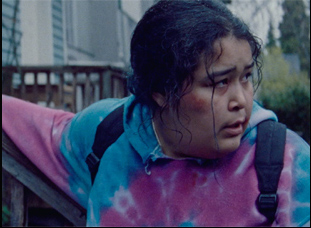
Violet Nelson: Honestly, I forgot the crew was there and that it was just acting. [laughs]
Elle-Máijá Tailfeathers: It felt so real. As an actor, I’ve always loved theater and the process of being able to rehearse for weeks before you go to stage and also the beauty in being able to perform the story from beginning to end in one go and the happy accidents that happen. There’s a really interesting tension that builds in that if you screw it up, you can’t stop. You have to keep going, so all of that happened in our one take. But we did a full crew rehearsal to choreograph everything because it had to be executed just so and then because we had to put so much rehearsal and prep into it, we were able to fall into this performance naturally – you fall into this rhythm and this natural momentum that builds – and lets it be something real and magic.
What’s it been like traveling with it?
Kathleen Hepburn: We were just in Los Cabos and we had a really wonderful experience with a young woman there…
Violet Nelson: Yeah, after the Q & A, she came up to Kathleen first and then she came up to me and explained that her mom went through a similar situation [where] she also witnessed her mom going through that and it kind of hit me, like well, she has a connection to that and I’m like, dammit, I’m crying… [laughs]
Elle-Máijá Tailfeathers: And that connection happens with almost every screening, so that’s been really profound. To have the film screen around the world and to know it’s resonating with audiences on a personal level, no matter where you’re from or your lived experience, they’re connecting with it on a personal level.
“The Body Remembers When the World Broke Open” is now streaming on Netflix here. It is playing a special engagement in Los Angeles at the Amanda Theater on the ARRAY Campus, starting November 29th. A full schedule of cities and dates is here.




